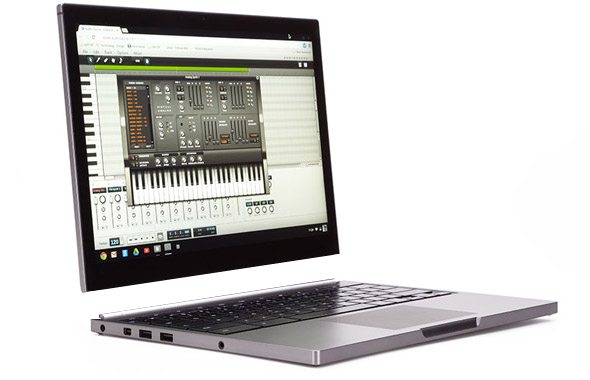6 Fixes to Make the Chromebook Pixel Worth Buying
I call them Chromebook Pixel apologists. They're coming out of the woodwork to defend Google's super-expensive but flawed $1,299 laptop. You'll hear things like “It obviously isn't for everyone” or “You either get it or you don't.” Count me as one of the people who don't get it. As I say in my Chromebook Pixel review, the quality, sharper-than-Retina display, booming speakers and superior touchpad and keyboard all make this a lust-worthy machine. But the Pixel's beauty isn't much more than skin-deep. If Google really wants to convert more shoppers to its flagship anti-MacBook, it's going to have to address the following issues head-on. And, yes, I'm sorry to say that some of my fixes will have to wait for Chromebook Pixel 2.

Add Android App Support
Silos are bad, and yet it seems like the Chrome OS and Android teams at Google don't even know each other exist. The Chrome Web Store would be a heck of a lot more robust if Google figured out a way to let Android apps run on its Chromebook. Doing this would not only vastly improve the selection of apps, it would let Pixel owners do a lot more offline. Adding Android app support would also give the touch screen on the notebook more reason for being. Would making such a move necessitate a merger of the two platforms? Maybe, and as I've said before, that wouldn't be a bad thing.
More: Top 20 Chrome Apps for Your Chromebook

Switch to a Tegra 4 Processsor for More Juice
I sort of get why Google opted for an Intel Core i5 processor. It gave the company the muscle needed for the Chromebook Pixels' 2560 x 1700-pixel screen. The MacBook Pro with Retina Display also uses a Core i5 CPU with Intel HD 4000 graphics to power its 2560 x 1600-pixel panel. The problem is that while the MacBook Pro has room for a heftier 74 watt-hour battery, the Pixel makes due with a 59 Wh battery. In our tests we saw a huge difference in endurance between the two machines: 7 hours and 38 minutes for the MacBook versus just 3:54 for the Pixel. A switch to Nvdia's more efficient Tegra 4 processor would allow Google to offer a lot more juice while upping the graphics performance—all without bloating the beautiful chassis.
More: 10 Laptops with the Longest Battery Life

Make 4G More Seamless
This fix qualifies as low-hanging fruit for Google. Right now, if you want to switch between the Wi-Fi and 4G LTE connection on the Chromebook Pixel (assuming you've paid $1,449 for the 4G version), you need to turn the Wi-Fi radio off in the settings menu. Why? You should be able to easily toggle between the 4G and Wi-Fi connection right in the mini setting box on the bottom right side of the screen. While Google is at it, please speed up the time it takes to re-connect to 4G LTE from sleep. I counted a long 30 seconds to get back to work, which is a long time to wait when you're just lifting the lid.
More: 4G Mobile Hotspots Showdown
Sign up to receive The Snapshot, a free special dispatch from Laptop Mag, in your inbox.

Go Convertible
If you're going to spend $1,299 or more for a touch laptop, it should give you the option of detaching the screen or at least flipping the display around so you can use the device as a tablet. The Lenovo IdeaPad Yoga is one sound approach, which lets you convert from notebook to slate mode by folding the screen back. On the detachable front, the HP Envy X2 and Samsung Ativ Smart PC line both make detaching and re-attaching the tablet portion a cinch. Assuming Google finds a way to combine the best aspects of Android and Chrome OS, a Pixel transformer would be a surefire winner.
More: Top 8 Windows 8 Tablet-Laptop Hybrids

Enable Pinch to Zoom by Default
Maybe Google is nervous that Apple's lawyers are watching, but for whatever reason the Chromebook Pixel's pinch to zoom feature on the touch screen doesn't work with most websites out of the box. The good news is that you can enable this feature yourself. First type “chrome://flags” in the address bar, then scroll down and select “enable pinch scale”. Restart your Pixel and voila! This option should be enabled out of the box. Unfortunately, pinch to zoom doesn't work on most websites with the otherwise awesome glass touchpad.
More: Top 10 Tablets Available Now

Include More Storage
Google is being quite generous with the Chromebook Pixel by offering a whopping terabyte of online storage for three years. Between your files, photos, music and videos, that's pretty much all you'd ever need. Apps are another story, though. Every time I tried to resume playing a cool game on the Chromebook Pixel like “Bastion,” the notebook would re-download 41 MB of data. What's the point of an 8-second boot time and instant resume time if you have to wait that long to get your game on? By offering more offline games and other apps and upping the standard amount of storage from 32GB to 64GB (or even 128GB, like most Ultrabooks), the Pixel could truly be the only PC you own.
More: How to Install an SSD Drive in Your Laptop
Editor-in-chief Mark Spoonauer directs LAPTOP’s online and print editorial content and has been covering mobile and wireless technology for over a decade. Each week Mark’s SpoonFed column provides his insights and analysis of the biggest mobile trends and news. You can also follow him on Twitter and Google+.

